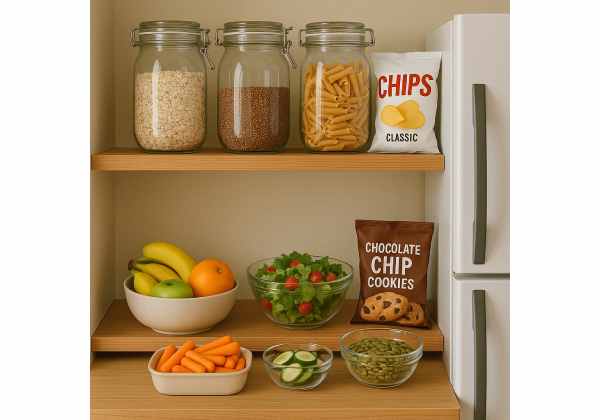
A food environment reset changes what you see, reach for, and cook—so healthier choices become the easy default. Instead of relying on willpower, you redesign your pantry and fridge to make protein-rich meals, high-fiber sides, and satisfying snacks automatic. This guide walks you through a practical audit, simple swaps, and layout tweaks that reduce friction at busy moments. It also covers shopping strategies, budgeting, and what to do when cravings hit at night. If you want a broader foundation for sustainable progress, explore our habits-first weight approach; then come back here to set up the physical system that supports those habits day after day.
Table of Contents
- What is a food environment reset?
- How to audit your pantry and fridge
- Smart swaps for meals and snacks
- Design your kitchen for success
- Handle cravings and night snacking
- Shopping strategy and budget tips
- Maintenance and troubleshooting
- Frequently Asked Questions
What is a food environment reset?
A food environment reset is a structured refresh of your pantry, fridge, freezer, and counter space to guide everyday decisions toward meals that are higher in protein and fiber, steadier in calories, and easier to assemble. Think of it as “choice architecture” at home. You are not banning foods; you are positioning default options so the quickest path also happens to be the most supportive for your goals.
Why it works:
- Visibility drives selection. The items you see first and reach for at eye level are eaten more often. Place lean proteins, prepped vegetables, and ready-to-eat fruit where your eyes land.
- Friction changes behavior. A closed container, a high shelf, or a step stool adds just enough effort to slow down impulse foods. Conversely, washed berries in a clear bin or hard-boiled eggs in the front row speed up good choices.
- Precommitment lowers decision fatigue. You stock and portion in advance so that “What’s for lunch?” becomes a two-minute assembly, not a 20-minute debate that ends with takeout.
What a reset includes:
- Audit: Remove stale foods, relocate triggers, and group staples by use case (breakfast, lunch boxes, quick dinners, training snacks).
- Swap: Replace common calorie traps with options that deliver more protein, fiber, or both, without sacrificing convenience.
- Design: Use zones, containers, and labels to create a “map” that makes your future self’s job easy.
- Plan: Build a short shopping routine and a Sunday 30-minute prep that sets up the week.
This approach aligns with evidence-based weight management: gradual calorie control, adequate protein to protect lean mass, and consistent routines. If you are new to the process, skim the core concepts in safe weight loss basics and then start here with small, high-leverage changes. The goal is not perfection—it is a kitchen that nudges you toward better choices 80–90% of the time without feeling deprived.
Key outcomes you should expect in the first 2–4 weeks:
- Faster breakfast and lunch decisions (under five minutes).
- Fewer late-night “foraging” laps; you know exactly what to grab.
- A steady grocery list with 10–15 items that always keep you covered.
- Less food waste because your layout matches how you actually eat.
How to audit your pantry and fridge
Set aside 60–90 minutes. You will touch every shelf once. Have three bags or boxes ready: Keep, Relocate, Donate/Discard. Work left to right.
Step 1: Empty and categorize
Pull items onto the counter and group by use: proteins, fiber-rich carbs, healthy fats, flavor boosters, treats. This reveals gaps (e.g., no quick protein) and excess (e.g., five kinds of crackers). Wipe shelves before restocking.
Step 2: Label, date, and portion
- Add a piece of masking tape with the purchase date to opened items.
- Create a “use-first” bin in the fridge door and a “this week” basket in the pantry.
- Pre-portion a few calorie-dense foods into small containers: nuts (28–30 g), granola (30–40 g), dark chocolate squares (10–15 g). You are not forbidding these—just defining a serving.
Step 3: Decide the fate of triggers
- Keep visible alternatives: If chips are a nightly habit, keep single-serve popcorn or roasted chickpeas front and center.
- Relocate, do not center: Put high-temptation items on the top shelf in opaque bins. If you must use a step stool, you will eat them less often.
- Discard stale foods: If the best-by date is past and the taste is off, let it go.
Step 4: Restock the foundation
Fridge/freezer:
- Cooked proteins: grilled chicken, turkey meatballs, baked tofu, lentils.
- Ready produce: washed salad mix, cherry tomatoes, baby cucumbers, steam-in-bag vegetables, frozen berries.
- “Instant” anchors: Greek yogurt, cottage cheese, eggs, pre-cooked rice or quinoa cups, frozen whole-grain bread.
Pantry:
- Proteins and fiber: canned tuna/salmon, beans, chickpeas, edamame, high-protein pasta, oats.
- Flavor and crunch: salsa, mustard, pesto, olive oil spray, spice blends, hot sauce, pickles.
- Smart treats: mini-dark chocolate bars, single-serve nut butter, microwave popcorn.
Step 5: Define your plate
Use the visual split that fits your goals: roughly ½ vegetables or fruit, ¼ protein, ¼ smart carbs, with a thumb-size amount of added fat at most meals. If you prefer numbers, target 25–35 g protein at main meals. For an overview of this approach, see the plate method and protein targets.
Step 6: Rebuild the shelves with intent
- Eye level: cooked proteins, cut fruit, washed vegetables, and single-serve snacks.
- Middle drawers and bins: sandwich/wrap fixings, yogurt, cheese sticks, hummus.
- Top shelf/opaque bins: desserts, chips, and any high-temptation items (still allowed—just not starring).
Common audit mistakes to avoid
- Keeping family favorites front and center “for the kids”—which you then eat at 10 p.m.
- Stocking only raw ingredients; when you are tired, raw chicken is not dinner. Always keep at least two ready proteins.
- Hiding produce in crisper drawers; if you do, it will die there.
Finish by taking a photo of your “after” layout. Use it as a reset template every Sunday.
Smart swaps for meals and snacks
Swaps work when they are equally convenient and taste good enough to repeat. Below are replacements that cut calories or add satiating protein and fiber—often both—without increasing prep time.
Breakfast
- Bagel with cream cheese → High-protein yogurt bowl: Greek yogurt (170 g) with berries, 20–30 g granola, and 1 tsp honey (saves ~150–200 kcal and adds ~15–20 g protein).
- Sugary cereal → Oat and egg scramble: quick oats cooked in milk, topped with scrambled eggs and salsa.
- Pastry → Egg wrap: egg, spinach, and cheese in a whole-grain tortilla; add smoked salmon or turkey for extra protein.
Lunch
- Large deli sandwich → Protein-packed salad box: 120–150 g grilled chicken or tofu, 2 cups mixed greens, crunchy veg, beans, and a vinaigrette. Add a slice of whole-grain bread if you need carbs.
- Fried rice takeout → Microwave “power bowl”: pre-cooked brown rice cup, steam-in-bag veggies, and frozen shrimp; toss with soy sauce and sesame seeds.
- Heavy pasta → High-protein pasta with tomato sauce, turkey meatballs, and a big side salad.
Dinner
- Creamy casseroles → Sheet-pan dinners: chicken thighs or firm tofu, chopped vegetables, and olive oil spray with spices; roast at 220°C for 20–25 minutes.
- Breaded cutlets → Air-fried or baked versions with panko and grated Parmesan; serve with lemon and slaw.
- Pizza night → Tortilla or pita pizza: whole-grain base, tomato sauce, light mozzarella, and lots of vegetables; pair with a side salad.
Snacks
- Chips → Popcorn (air-popped or light microwave) or roasted chickpeas; portion to 2–3 cups.
- Candy bar → Greek yogurt + cocoa + berries or cottage cheese + pineapple.
- Crackers and cheese → Apple slices with peanut butter (1 tbsp) or rice cakes with hummus and turkey.
For more plug-and-play ideas, use the quick protein and fiber toolkit: pair a protein (yogurt, eggs, tuna, tofu) with a fiber source (fruit, vegetables, beans, whole grains) and you have a satisfying mini-meal in minutes.
Beverages and desserts
- Soda → Sparkling water with a squeeze of citrus.
- Sugary coffee → Americano with a splash of milk or a protein shake on the side.
- Ice cream every night → Yogurt bark: Greek yogurt spread on parchment with berries and a few chocolate chips; freeze and break into pieces.
Guidelines for choosing your own swaps
- Match the ritual. If you like something crunchy at 3 p.m., choose a crunchy alternative, not just “a banana.” Texture matters.
- Keep protein in the frame. Aim for at least 10–20 g protein when a snack replaces a meal; 5–10 g for a small snack.
- Add fiber where possible. Fruits with skin, raw vegetables, beans, and whole grains increase fullness.
- Mind the condiments. A tablespoon of mayo or butter can add 90–100 kcal. Swap in mustard, salsa, or yogurt-based sauces most days.
Remember: a swap is “smart” only if you will use it next week. Test a few, keep the winners, and ignore the rest.
Design your kitchen for success
Your kitchen can make healthy choices the default without feeling strict. Use these design tactics to nudge future decisions.
Create clear zones
- Grab-and-go shelf (fridge): yogurt, cottage cheese, cheese sticks, hummus packs, cut fruit, cooked proteins. Put these at eye level.
- Lunch assembly bin (pantry): wraps, tuna pouches, beans, microwave rice, pickles, salsa.
- Flavor station: spices, olive oil spray, vinegar, hot sauce, pesto; keep a teaspoon and measuring spoon beside them.
Use containers that guide behavior
- Clear bins for fruit and vegetables so you see what to use first.
- Small glass jars for nuts, seeds, and granola with pre-portioned lids (¼ cup).
- Opaque bins for treats; if you cannot see them, you will not graze on them.
Reduce friction for the “good stuff”
- Wash berries and salad greens as soon as they come home; line bins with paper towels to extend freshness.
- Boil a dozen eggs on Sunday; peel half.
- Pre-cut a few “builder” vegetables (cucumber, peppers, carrots) and store in water to stay crisp.
Make cooking easy to start
- Keep a sheet pan and parchment paper within arm’s reach.
- Store the air fryer on the counter if you use it more than twice a week.
- Put a kitchen scale and a set of small containers beside the cutting board; you will portion by default.
Stack habits onto existing anchors
Attach food prep to routines you already do—coffee brewing, Sunday laundry, or unloading groceries. For a broader method of combining small actions, see habit stacking. Ten minutes, done consistently, beats a once-a-month marathon prep.
A note about families and roommates
You do not need a separate “diet kitchen.” Use zones to respect everyone’s preferences: keep shared staples visible and treats in individual opaque bins with names on them. Boundaries prevent “I bought that for me” conflicts.
Handle cravings and night snacking
Nighttime grazing is often a mix of biology (low protein, low fiber, long gaps between meals), cues (TV, couch), and emotion (stress, boredom). Build a simple protocol you follow without debate.
Preempt the problem earlier in the day
- Hit 25–35 g protein at dinner and include volume vegetables (2 cups salad or roasted veg).
- Do not skip the carb anchor if it helps control later cravings: ½–1 cup potatoes, rice, or whole-grain bread.
Create a “green-zone” snack list
Pick two options you like that you can grab in under a minute:
- Greek yogurt with frozen berries.
- Cottage cheese with cherry tomatoes and pepper.
- Air-popped popcorn with a sprinkle of Parmesan.
- Apple or pear with 1 tbsp peanut butter.
- Protein shake blended with ice.
Place these at eye level; put desserts in opaque bins. If you still want dessert after a green-zone snack, have a small portion—mindfully plated.
Interrupt the autopilot
- Brush teeth right after dinner.
- Give yourself a 10-minute pause: make herbal tea, stretch, or take a short walk.
- Change the environment: turn on a lamp in the kitchen and close the pantry door; small visual cues help.
If cravings keep winning
Check your day: Was lunch too light? Did you nibble instead of eating a proper meal? Are you going to bed late? Target the real cause rather than fighting symptoms. For specific night strategies, review night snacking fixes and choose one to try this week.
When comfort is the goal
Sometimes you want a treat, not a lecture. Choose the smallest portion that feels like “enough,” plate it, enjoy it slowly, and move on. A planned square of chocolate or a mini ice cream can fit when the rest of the day is balanced.
Shopping strategy and budget tips
Smart shopping keeps your kitchen reset running with minimal time and waste. The secret is a short, repeatable list and a store path that avoids impulse zones.
Build a two-column list
- Always buy: eggs, Greek yogurt, cottage cheese, salad mix, cherry tomatoes, cucumbers, frozen vegetables, berries, bananas, canned beans, tuna, whole-grain wraps, rice cups.
- Rotate weekly: chicken thighs or tofu, turkey meatballs, smoked salmon, high-protein pasta, pesto, salsa, nuts, popcorn, sweet potatoes.
Print or save the list on your phone; check off what you need. When life gets busy, the list does the thinking for you.
Use a “first meal, then pantry” rule
Plan three anchored meals for the week (e.g., sheet-pan chicken, high-protein pasta, taco bowls). Shop those ingredients first, then add snacks and staples. This prevents a pantry full of charming but random items.
Compare unit prices and buy smart bulk
- Buy bulk proteins only if you portion and freeze the same day.
- Choose frozen fruit and vegetables when prices spike; nutrition is comparable and waste is lower.
- For nuts and seeds, smaller containers can save money by preventing mindless over-pouring.
Alcohol and extras
Drinks can quietly add hundreds of calories per week. If you do drink, consider lower-calorie choices and limits, and treat them like dessert—planned and portioned. Keep mixers sugar-free and alternate with water.
Navigate the store with intent
- Shop the perimeter for produce, dairy, and proteins; then hit targeted middle aisles (beans, grains, spices).
- Avoid the bakery when you are hungry. If you want a treat, decide before entering and buy the single item, not a family pack.
Stock safety nets
Keep two dinners that always work: a frozen protein plus steam-in-bag vegetables, and a pantry pasta with canned tuna and tomatoes. Safety nets save money and reduce the urge to order out.
Maintenance and troubleshooting
A reset is not a one-time event; it is a system that you refresh. Expect lapses. What matters is how quickly you reset the environment.
Weekly 30-minute refresh
- Toss wilted produce and move “use-first” items to the front.
- Refill grab-and-go proteins and portion small calorie-dense foods.
- Cook one batch item (lentils, chicken, tofu) and wash a salad base.
Monthly audit
- Repeat the shelf check: are your triggers creeping toward eye level?
- Review your grocery list. Promote items you used often; drop those you did not.
- Try one new high-protein recipe and retire one that felt like a chore.
Troubleshooting common issues
- Night snacking returned: Increase dinner protein and add a small carb; set your green-zone snacks at eye level again.
- Weekend blowouts: Add a Saturday lunch anchor (e.g., big salad with protein) and keep a frozen dinner back-up for Sunday night.
- Busy week meltdown: Pre-order groceries for pickup and rely on your two safety-net dinners.
Travel and office life
- Pack a “protein kit”: tuna pouch, jerky or baked tofu, nut butter, and a shaker bottle.
- On the road, aim for the same template: protein + fiber + a small carb. Supermarket meals beat random snacks.
- At the office, stash microwavable rice, soup, and a few cans of beans in your desk or team cabinet.
Mindset
Perfection is fragile. Systems survive real life. When you fall off, your kitchen layout is there to catch you. Take a photo of your shelves after a good reset and use it as your North Star whenever you feel off track.
Frequently Asked Questions
How long does a food environment reset take?
Most people can audit, restock, and reorganize in 60–90 minutes. Add another 20–30 minutes to pre-cook a protein and wash produce. Plan a quick 15-minute refresh each Sunday so the system stays sharp without turning into a chore.
Do I have to throw away all treats?
No. Keep treats, but change their position and portion. Store them in opaque bins on a higher shelf and buy smaller units. When you want one, plate a modest portion, enjoy it mindfully, and move on. This preserves enjoyment while reducing mindless grazing.
Will this work if I do not count calories?
Yes. By centering protein and fiber and using the plate method, many people naturally reduce intake. Aim for 25–35 g protein at meals, add vegetables or fruit, and keep calorie-dense items portioned. If progress stalls, tighten portions or track briefly to recalibrate.
What are the best quick snacks to keep visible?
Choose snacks that pair protein + fiber: Greek yogurt with berries, cottage cheese with tomatoes, popcorn with Parmesan, tuna on rice cakes, or an apple with peanut butter. Keep two favorites at eye level so they are faster than foraging for sweets.
How do I handle family members who want different foods?
Use zones. Keep shared staples visible and label individual treat bins by name. Build dinners around a flexible base—protein, vegetables, and a starch—so each person can customize with sauces or wraps. This respects preferences without derailing your plan.
How often should I repeat the reset?
Do a light refresh weekly and a fuller audit monthly. Replace what you use most, rotate one new item to prevent boredom, and recheck shelf placement. If life gets chaotic, return to your two safety-net dinners and rebuild from there.
References
- The effectiveness of nudging: A meta-analysis of choice architecture interventions across behavioral domains 2022 (Systematic Review/Meta-analysis)
- A randomized study of food pantry environment-level change following the SuperShelf intervention 2022 (RCT)
- Impacts of protein quantity and distribution on body composition 2024 (Review)
- Systematic review and meta‐analysis of protein intake to support muscle mass and function in healthy adults 2022 (Systematic Review/Meta-analysis)
- The Importance of Dietary Fiber for Metabolic Health 2023 (Review)
Disclaimer
This guide offers general nutrition and organization information for healthy adults. It is not medical advice and does not replace consultation with a qualified clinician or registered dietitian. If you have a medical condition, food allergies, or take medications, discuss dietary changes with your healthcare provider.
Share and follow
If this article helped you reset your kitchen, consider sharing it with a friend or family member who might benefit. You are also welcome to follow us on Facebook, X, or whichever network you use to stay updated on practical, evidence-based guides like this one.










